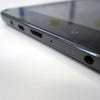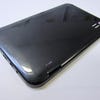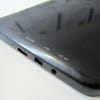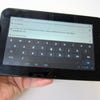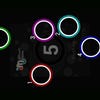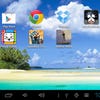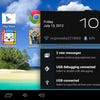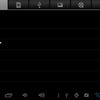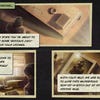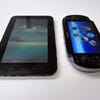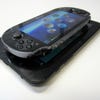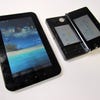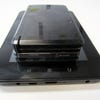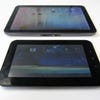The £50 Android Tablet Experience
A 7-inch Android 4.0 slate with capacitive screen for boxed game money? Digital Foundry had to find out more.
While Apple is content to keep the price of its iPad range reasonably high, the open nature of Google's Android operating system has resulted in a deluge of low-cost slates from the technological sweat shops of the Far East. It would be easy to dismiss such devices as cheap and nasty, but with many selling for less than your average pay-as-you-go mobile phone, this is surely a sector of the market which demands further investigation. Three weeks ago, pricing reached a new all-time low: a capacitive screen tablet, running Android 4.0, was available for just £50 - and we just had to find out what kind of experience you got for the money.
Shopping in this area is a minefield, largely due to the anonymous nature of the products themselves; it's not uncommon to find the exact same tablet branded with several different monikers and retailed by multiple distributors - just like the Scroll Extreme slate we reviewed back in April. However, in general, most of the 7-inch variants tend to share a common bond in the fact that they utilise the ARM-based "AllWinner" chipset, a low-cost alternative to the more expensive offerings from the likes of NVIDIA and Qualcomm. Our test model was no different.
Our tablet is known as the NATPC M009S RTB - although it comes in generic box with generic instructions, and features no branding whatsoever - and it's available from Amazon supplier Wendy Lou, who supplied us with a review unit. Other variants - each with slightly different specifications - exist at higher RRPs, and it may pay to shop around. The review unit that actually turned up is closer to the £70 model. This is identical to what was then the £50 offering, with the additional bonus of a 25 per cent larger battery, more RAM and HDMI output. However, the CPU runs with lower clocks.
Clearly the market value of these tablets is influenced by the ebb and flow of production, with specs seemingly changing with the tides. The price of the base model has risen since we received our review unit, but keep a look out on the bargain forums and they'll be sure to drop again.
Design and Screen Quality
Given the M009S' low cost, it shouldn't come as too much of a shock to learn that its external casing is constructed almost entirely from glossy plastic, heavily prone to attracting fingerprints and smearing. There's been little effort to make this tablet appealing in a purely aesthetic sense; the design is nondescript - there isn't even a manufacturer's logo or model name anywhere on the device, and faux-metallic stickers crudely inform the user of the internal memory capacity and RAM allocation. It's the textbook definition of function over form.
Bearing in mind the price-point that's fair enough, of course. However, the decision to go with low-grade materials has ramifications for the overall user experience. If you apply any kind of pressure to the rear of the device during use, the LCD screen ripples like a puddle during a downpour; even drumming your fingers on the back of the casing causes distortion. This isn't the only tablet to suffer from this issue - Archos' G9 range of dual core slates is afflicted with similar problems - but it's irksome to say the least. With time, you learn to adjust your grip and thereby avoid this problem, but it makes you appreciate the need for rigid metal chassis in this kind of device. On the upside, the case itself doesn't creak under pressure, or feel as if it's going to fall apart if accidentally dropped.
"The screen itself is just as you'd expect from a bargain basement product like this; colours are washed out, brightness is lacking and viewing angles are poor."
The screen itself is just as you'd expect from a bargain basement product like this; colours are washed out, brightness is lacking and viewing angles are mostly dire. When holding the tablet in landscape, the screen becomes almost illegible once the M009S is tilted a few degrees away from you.
If you're coming from a retina-equipped iPad 3 - though we can't see any reason why you should be - the resolution is going to be a shock. 800x480 pixels is lower than many mobile phones these days, but on the plus side, the low pixel count means the processor is put under less strain, and that generally means a more responsive experience. It's almost certainly the right pixel density for the relatively meagre processor power available.
Technical Performance, Gaming, Camera Quality and Battery Life
The M009S' AllWinner chipset is comprised of ARM's Cortex A8 CPU clocked at just under 1GHz combined with a Mali 400 graphics processor. This is clearly an entry-level spec, but the budget slate is actually quicker than you might imagine; general performance is better than what we've seen on other low-cost examples in this sector, but not without its hiccups.
However, as a web browsing tool, the M009S makes a lot of sense. Because it's powered by Android 4.0, it's capable of running the mobile version of Google's Chrome browser, which is arguably the best of its kind available on any tablet right now. It syncs with the desktop version of Chrome, seamlessly transferring bookmarks, passwords and search history, as well as offering a visually alluring UI. Browsing in general obviously isn't as smooth as it is on a quad core device, but we'd say it's comparable to the experience we got from the dual core Motorola Xoom (at a lower resolution of course). YouTube playback was laggy from within the browser, but absolutely fine when using the dedicated app. Of course, being an Android device, the M009S also comes with all the usual benefits of the platform, namely cloud storage for contracts, email, pictures, music and video, and access to the burgeoning Google Play market.
"Benchmarks pretty much confirm what we would expect from an entry-level device - it's comfortably outclassed by most Android phones and tablets."

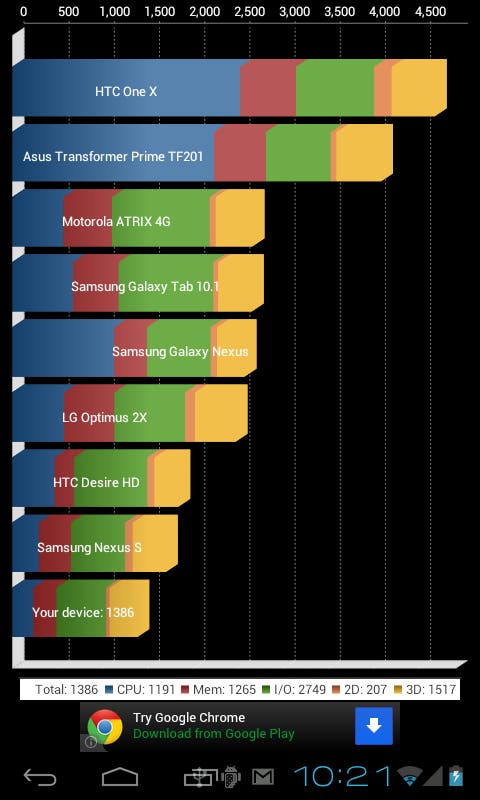
The usual Google grumbles apply here. When compared to Apple's iOS, Android isn't anywhere near as fluid, smooth or intuitive. That truth applies to versions of the OS running on quad core monsters just as much as it does here. The recent launch of Android 4.1 - also known as Jelly Bean - is a positive step towards eradicating the annoying stutter that seems to plague Google's software, but it remains to be seen if a low-cost device such as the M009S is going to get a firmware upgrade. For now, the overall experience is just about acceptable, but you can expect to encounter plenty of pauses, frozen applications and lag.
We also noticed that many games aren't compatible with the tablet. Titles such as Max Payne and Six-Guns are understandable, seeing as they're relatively demanding in a graphical sense, but many others simply refused to install, stubbornly displaying the "not compatible with your device" warning on their Google Play market page. Others - such as Speedball 2: Evolution - wouldn't load past the introduction screen. It would be harsh of us to brand this as the only Android device with compatibility issues, but we were surprised at just how many downloads refused to play ball with the hardware.
When you do locate a game that runs, the M009S' lack of muscle becomes apparent. Titles like Another World and Death Rally are sluggish and jerky, and we noticed the sound also jumps and skips during play. 2D games - like Angry Birds - suffer less, but it's clear that serious mobile gamers aren't going to get much joy from this. It's a shame, because the M009S comes with a USB adapter which allows you to plug in joypads, so the potential is there for a neat little mini-console.
"The tablet disappoints for gaming, but does the job it was intended for - providing basic tablet functionality with relatively decent battery life."
To cut costs, there's no rear-facing camera on this tablet. Instead, you have to make do with a front-facing snapper, mainly intended for video calls using services such as Skype. It captures still images at VGA resolution, and the results aren't as poor as you might imagine. If you're only looking to post to services such as Facebook and Twitter, then there's no real reason to complain. Besides, the very notion of taking part in serious photography or recording with a tablet is a faintly ludicrous idea any way - even with a small 7-inch slate, it's frustratingly awkward. This viewpoint seems to be gathering support elsewhere too; Google and Asus have removed the rear-facing camera from their newly-launched Nexus 7 collaboration.
There's a 4000mAh power cell inside this iteration of the M009S (it's 3000mAh in the base model), and when you take into account the low-resolution screen and modest processor, that battery is able to go a long way. You'll get a few days of solid use between charges, although this can naturally drop if you indulge in power-hungry activities, such as watching HD movies. Speaking of which, the packaging of the M009S proudly proclaims that it can handle 1080p video, which it can - but you're obviously not viewing it at that resolution, unless the screen is magically deploying additional pixels during playback. This is where the HDMI output comes in handy, if you opt for the more expensive model.
The £50 Android Tablet Experience: The Digital Foundry Verdict
With this £50 slate, you get what you pay for. Performance is sketchy, build quality is poor and the screen lacklustre. Despite running a fairly recent build of Android, the M009S is bogged down by compatibility problems with games and applications - not an amazing surprise when you consider the fractured nature of Google's OS, but it seems to be felt more keenly here than usual.
However, the M009S' day-to-day performance isn't as bad as you might expect, and if you're only after a device to surf the web, read eBooks and play the odd game of Angry Birds, then this could well be an option - especially when you consider that the monochrome Amazon Kindle costs more, and is roughly the same size.
"The very existence of this slate provides food for thought. Clearly, the technology is constantly evolving and improving and you have to wonder just how capable next year's £50 tablet will be."
Indeed, pricing is the main reason you'd even consider such a purchase. While the overall experience is lacking in many respects, you have to wonder if a tablet which costs four or even five times the amount can really be as many times as enjoyable or functional. It could also be argued that the smaller form factor of 7-inch tablets makes them a more sensible option when selecting your portable companion of choice; the M009S' low cost makes it even easier to instinctively slip into your bag when embarking on a short trip, as you're less likely to worry about damaging it. As a basic browsing/mail machine with media playback facilities, the fact is, it works.
Even if you baulk at the prospect of splashing out £50 on an entry-level slate, the very existence of the M009S - and the many other budget examples like it - provides food for thought. We've gone from unusable £100+ tablets with resistive touch-screens and no substantial app support to capacitive displays as standard, relatively decent Android support and 1GHz processors - with price-points hitting £50. Clearly, the technology is constantly evolving and improving and you have to wonder just how capable next year's £50 tablet will be. Not only that, but the race to the bottom is creating a legion of similar products, and combined with Google's brave pricing of its Nexus 7 slate, this could have significant ramifications for the premium tablet market as it exists now.




